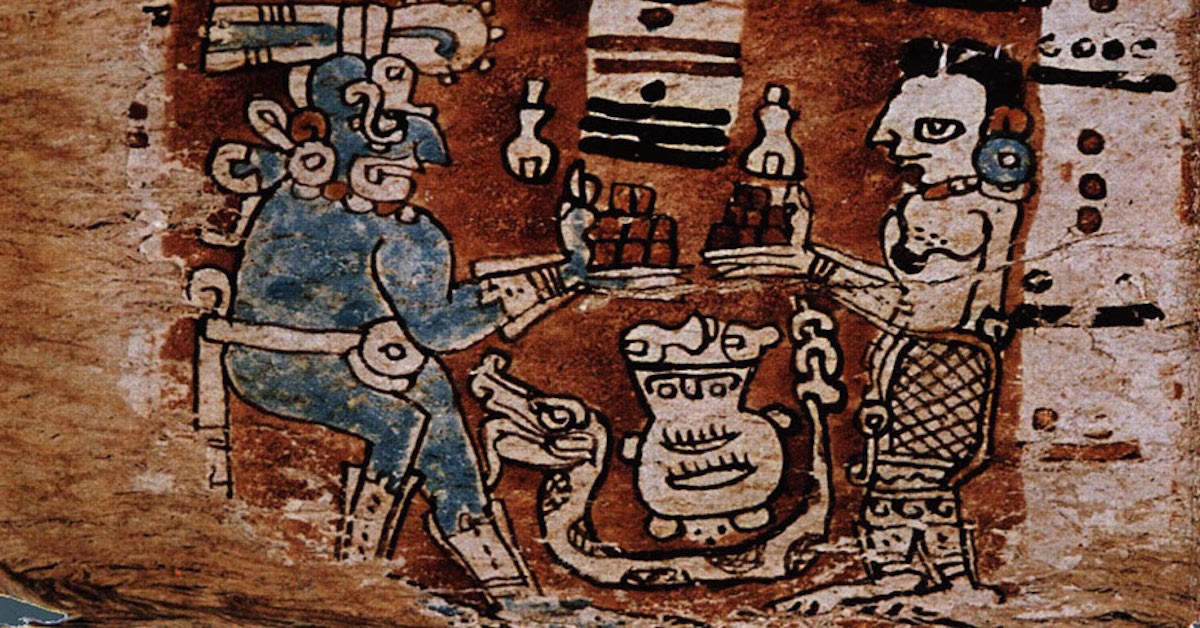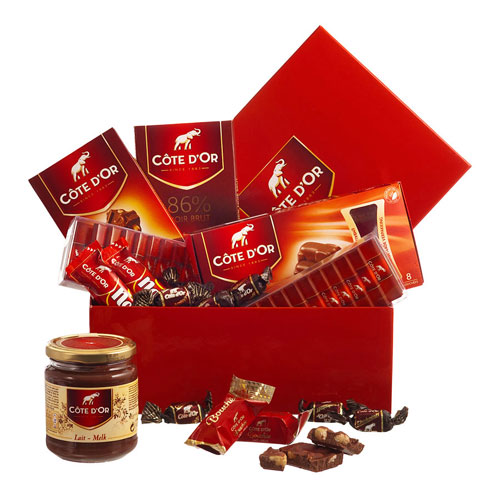Raquel Esperanza Knecht
Victoria Brion
Yolanda Frazao Sophie Gach
History of chocolate

As everyone may not know, chocolate has an exotic origin. Indeed, the first people to consume chocolate were the Hispanic civilizations such as the Mayas or the Aztecs. It’s logical because the tree that produces the cacao beans grows in tropical area. Central America is a place where those plants can find all they need to grow well. Some archaeologist proved that cacao beans were already consumed by humans from 1100 to 1400 B.C. Those beans were used in the fabrication of a beverage that was not yet chocolate. They used to make the beans ferment and collect the liquid. Some time later, chocolate was created.

At first, precolonial civilizations used to produce it as a sweet drink. At that end of the that period, it was a luxurious drink in the whole Mesoamerican area. People were even using it as currency instead of money because it was considered really precious. The Mayas were not using money at all, but cacao beans and xocoalt (the name of their preparation). The preparation of the chocolate drink was changing from one location to another. When Aztecs were more into spicing the beverage, Mayas would add vanilla or sugar to sweeten it. The primitive form of chocolate was also used as gift to the chiefs of the tributes, to the gods and goddesses. Aztects were associating chocolate with Xochiquetzal, the goddess of the fertility. It was a really valuable element of their culture.
Then Christopher Columbus discovered America and so chocolate also. Most of the Europeans didn’t like it at first because they found it too bitter, but later, it became a truly popular product in the Spanish court. Some sweet producers tried to find a way to make it more tasty. In all over Europe, chocolate became a really well-liked candy, but it’s in Switzerland that a great candy maker found the perfect balance and created the chocolate as we all know it now.
History of the brands
Lindt & Sprüngli

The story begins in 1845. The confectioner, David Sprüngli-Schwarz and his inventive son, Rudolf Sprüngli-Ammann, own a small confectionery shop in the Marktgasse of Zurich’s Old Town.
They decide to be the first ones in the German speaking part of Switzerland to manufacture chocolate in a solid form. Even at that time, as many as ten workers were employed.
In 1859, Sprüngli and Son opened a second and larger confectionery and refreshment room on Zurich’s Paradeplatz.
When Rudolf Sprüngli-Ammann retired from commerce in 1892, he had acquired a widespread reputation for the quality of his products and as an expert in his field. He divided the business between his two sons: The younger, David Robert, received the two confectionery stores. The elder brother, Johann Rudolf Sprüngli-Schifferli, received the chocolate factory from his father.To raise the necessary finances, he converted his private company into ”Chocolat Sprüngli AG” and at the same time he was offered the option of acquiring the small, but famous, chocolate factory of Rodolphe Lindt in Bern. So how was Lindt born?

It was in 1879. Rodolphe Lindt, the son of a Bernese pharmacist, wanted to make chocolate. “Do you know what chocolate was like at the time? It was hard: hard to process and hard to eat.” So he bought an old factory hall with antiquated machines. Unfortunately, nothing was working. He wanted to give up when.. came that Friday evening he was about to leave the factory without having finished his work – and more importantly, without having switched off the machines. Did he forget to do because he was in such a hurry? Or was it intentional? Did he have a hunch or was it a small act of defiance? We don’t know. But the machine continued to run: for a whole weekend. When Rodolphe Lindt entered his factory on the following Monday morning, he was initially shocked. But what he found in the stirring tank was anything but hard, burnt chocolate mass. It shone; it smelt wonderful, and when he tasted some of it, he was the first person ever to experience how chocolate melts in the mouth. He was in seventh heaven.
Côte d’Or

At the beginning of twentieth-century, Belgians, with the colonial expansion, were interested in the discovery of new flavours and particularly the chocolate. Côte d’Or was created in 1983 by Charles Newhouse. The name comes from, “La Côte d’Or”, which is now the country of Ghana, where the cacao beans were picked.

The elephant with an upturned trunk in the logo was designed in 1906 and has become one of world’s most loved and recognized chocolate brands.
In 1987, Jacobs Suchard purchased Cote d’Or. Kraft Foods purchased Jacobs Suchard in 1990. In 1911, Côte d’Or launched the first Côte d’Or chocolate bar. In 1930, Côte d’Or grew its business abroad thanks to the universal exhibition. From 1940 to 1946, the brand Congobar replaces Côte d’Or especially because of the second world war. In 2005, new flavors were created, more exotics thanks to the new commitment of the brand, the fair-trade, and that’s the brand we all know nowadays.
Production facility
Let’s start with some facts about chocolate production.
Did you know that…
… the largest factory is the Hershey Chocolate Factory in the USA?
… not Lindt, but Teuscher is the largest Factory in Switzerland and the second largest of the world?
… the third largest factory in the world is Godiva Chocolatier in Belgium?
Lindt & Sprüngli – Kirchberg, Switzerland
Lindt gets its cocoa beans from Central America and east Africa. They are harvested by hand and carefully selected. The workers check if all of the cocoa beans can be used for Lindts production and after they ship the cocoa to the different factories all around the world. In these factories, they process cocoa in the varied kinds of chocolate Lindt has.

Factories: – Kilchberg, Switzerland – Induno Olona, Italy – San Francisco, USA – New Hampshire, USA – Aachen, Germany
The biggest production facility is the one in Aachen, which means that most of the Lindt Chocolate is produced in Germany and not in Switzerland.
Côte d’Or – Halle, Belgium
Côte d’Or has its cocoa beans mostly from Ghana. That is why the brand is called Côte d’Or (Gold coast) referring to the old name of contemporary Ghana. In 2001, Côte d’Or had been continued questioned about their ethical stance because the media discovered that in their cocoa farms children worked. After the bad publicity, they joined the Rainforest Alliance Certified. It is an organization from Kraft Foods that makes sure that there is no child labour or bad working conditions. Côte d’Or was one of the first to join this organization. In contrast to Lindt, they sort the beans out in the different production facilities all around the world.

Factories: – France – Netherlands – Great Britain – USA
Economics
Chocolate is one of most underestimated businesses in the world. The worldwide consumption of chocolate each year is 7.2 million tons and 50% occurs on the European continent. So, as you can see, the chocolate business is booming. The annual estimate sales of chocolate around the world contribute 83 billion dollars to the global economy.

What do you think is the top chocolate consumption holiday in America? To be honest, I thought is must be Valentine’s Day or Easter, but it is actually Halloween. During Halloween, people buy and consume over 90 million pounds. In the second and third places are Easter with 71 million tons and Valentine’s Day with 48 million tons. So if you add everything together, in total, people in America consume over 210 million pounds just during three holidays.

On an average Valentine’s Day nearly $400 million of is purchased on chocolate around the world. In numbers, this is 5% of the industry sales.
Except the Asian countries, chocolate is sold the most in every other

country in the world. For example, the top four chocolate consumption countries in the world are Switzerland with 8,8kg per person (19,4lb), Austria with 8.1 kg (17,9lb), Germany with 7.9 kg (17,4lb) and Belgium with 5.6 kg (12,3lb) per person. Can you imagine that they eat so much chocolate alone? Let me give you an example that you can imagine this number better. That means one average person from Switzerland eats 88 Lindt chocolate bars a year.
As you already know, Switzerland produces most of their chocolate in Germany. That is the reason why Germany is the biggest exporter of chocolate products on the world with $3.8 billion a year. In the second place is Belgium with $2.6 billion and France with $1.6 billion. On the other side, the top three importers of chocolate are the USA with $2.5 billion, Germany with $2.4 billion and France with $2.4 billion as well.

